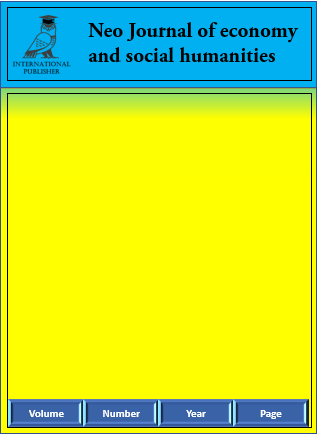Implementation of Population Policy Towards Indonesia’s Golden Vision 2045: Strengths and Future Challenges
DOI:
https://doi.org/10.56403/nejesh.v4i4.352Keywords:
Demographic dividend, Population policy, RPJPNAbstract
This study aimed to analyze the advantages and drawbacks of Indonesia’s population policy within the framework of the National Long-Term Development Plan (RPJPN) 2025–2045. The objective was to examine how demographic management can contribute to realization of the Indonesia’s Golden Vision 2045. A qualitative research method was applied through a literature review, focusing on strategic themes such as optimizing the demographic bonus, controlling population growth, developing intermediate cities, and promoting social inclusion for vulnerable groups. The study drew on academic articles, policy documents, and official government reports, purposively selected to represent the most relevant and updated sources. The instrument used in this study was a document analysis matrix to categorize findings according to opportunities and challenges. The results indicated that the RPJPN 2025–2045 provided a strong strategic direction to harness demographic momentum by enhancing human capital and economic productivity. However, challenges were identified in the form of regional development disparities, unequal access to basic services, risks of uncontrolled urbanization, and potential increases in unemployment if education and employment sectors were not adequately prepared. This study concluded that strengthening local-level policy implementation, mainstreaming inclusive development, and fostering cross-sectoral synergy were essential for effective demographic management. The findings were expected to support the development of adaptive and sustainable population strategies that could ensure Indonesia’s demographic advantages were transformed into long-term national progress.
References
Amornkitvikai, Y., Harvie, C., & Karcharnubarn, R. (2023). The impact of demographic structure, human capital, migration and environmental degradation on economic growth in Asia. Journal of Economic Studies, 50(2), 216–233. https://doi.org/10.1108/JES-09-2021-0487
Anshori, L. (2021). Analisis Pengaruh Aglomerasi, Urbanisasi, Dan Investasi Terhadap Ketimpangan Kabupaten/Kota Di Provinsi Banten. Jurnal Ilmiah - Jurusan Ilmu Ekonomi Fakultas Ekonomi Dan Bisnis Universitas Brawijaya Malang, 1(1), 1–14.
Anshori, L. (2021). Analisis Pengaruh Aglomerasi, Urbanisasi, Dan Investasi Terhadap Ketimpangan Kabupaten/Kota Di Provinsi Banten. Jurnal Ilmiah - Jurusan Ilmu Ekonomi Fakultas Ekonomi Dan Bisnis Universitas Brawijaya Malang, 1(1), 1–14.
Badan Perencanaan Pembangunan Nasional/Badan Perencanaan Pembangunan Nasional. (2024). Rencana Pembangunan Jangka Panjang Nasional (RPJPN) 2025–2045. Badan Perencanaan Pembangunan Nasional/Badan Perencanaan Pembangunan Nasional. https://indonesia2045.go.id/
Badan Pusat Statistik. (2019, September 25). Persentase Unmet Need KB (Kebutuhan Keluarga Berencana/KB Yang Tidak Terpenuhi) Menurut Provinsi (Persen), 2012-2017. Badan Pusat Statistik. Diakses dari https://www.bps.go.id/id/statistics-table/2/MTMyNiMy/persentase-unmet-need-kb-kebutuhan-keluarga-berencana-kb-yang-tidak-terpenuhi-menurut-provinsi.html
Badan Pusat Statistik. (2023). Indonesia Population Projection Based on Census 2020.
Badan Pusat Statistik. (2024, Juni 11). Jumlah Penduduk Menurut Kelompok Umur dan Jenis Kelamin, 2023. Badan Pusat Statistik. Diakses dari Amornkitvikai, Y., Harvie, C., & Karcharnubarn, R. (2023). The impact of demographic structure, human capital, migration and environmental degradation on economic growth in Asia. Journal of Economic Studies, 50(2), 216–233. https://doi.org/10.1108/JES-09-2021-0487
Badan Pusat Statistik. (2024, Juni 11). Jumlah Penduduk Menurut Kelompok Umur dan Jenis Kelamin, 2023. Badan Pusat Statistik. Diakses dari https://www.bps.go.id/id/statistics-table/3/WVc0MGEyMXBkVFUxY25KeE9HdDZkbTQzWkVkb1p6MDkjMw==/jumlah-penduduk-menurut-kelompok-umur-dan-jenis-kelamin--2023.html?year=2023
Badan Pusat Statistik. (2024, November 15). Indeks Pembangunan Manusia menurut Provinsi, 2022-2024. Badan Pusat Statistik. Diakses dari https://www.bps.go.id/id/statistics-table/2/NDk0IzI=/-metode-baru-indeks-pembangunan-manusia-menurut-provinsi.html
Breau, S., Wylie, M., Manaugh, K., & Carr, S. (2023). Inclusive growth, public transit infrastructure investments and neighbourhood trajectories of inequality in Montreal. Environment and Planning A: Economy and Space, 55(8), 2009–2030. https://doi.org/10.1177/0308518X231162091
David E. Bloom & David Canning. (2004). NBER- National Bureau of economic Research. “Global demographic change: dimensions and economic signifciance.” Working Paper 10817 http://www.nber.org/papers/w10817.
Direktorat Jendral Kependudukan dan Catatan Sipil. (2025). Perkembangan Data Dukcapil Capaian Perekaman Data Kependudukan Indonesia.
Elo, S., & Kyngäs, H. (2007). The qualitative content analysis process. Journal of Advanced Nursing, 62(1), 107–115. https://doi.org/10.1111/j.1365-2648.2007.04569.x
Firman, T. (2009). The continuity and change in mega-urbanization in Indonesia: A survey of Jakarta-Bandung Region (JBR) development. Habitat International, 33(4), 327–339. https://doi.org/10.1016/j.habitatint.2008.08.005
Fitriani, Nurmandi, A., Lawelai, H., Kasiwi, A. N., & Younus, M. (2025). Trends and Challenges of Digital Transformation in the Public Sector : Policy Implications for Improving Public Services in Indonesian Department of Public Administration , Universitas Muhammadiyah Sidenreng Rappang , Department of Government Affairs and. 13(2), 681–705.
Handoko, D. N., Viqri, A. A., Yulius, A. B., & Ummah, A. (2024). Kesenjangan dan Ketidaksetaraan: Tantangan Pemenuhan Hak Kesehatan di Daerah Terpencil Nias. Jurnal Ilmiah Kajian Politik Lokal dan Pembangunan, 10(3), 67–68.
Hikmah, N., Rahman, H., & Puspitasari, A. (2020). Membandingkan Ketimpangan Ketersediaan Tenaga Kesehatan Puskesmas Di Wilayah Indonesia Timur. Window of Public Health Journal, 1(1), 31–37. https://doi.org/10.33096/woph.vi.36
Mason, A., & Kinugasa, T. (2008). East Asian economic development: Two demographic dividends. Journal of Asian Economics, 19(5–6), 389–399. https://doi.org/10.1016/j.asieco.2008.09.006
Mcdonald, P. (2001). Theory pertaining to low fertility Introduction: grand or middle-range theory? International Perspectives on Low Fertility: Trends, Theories and Policies, Guinnane 1991.
Melo, R. H., Lasulika, C. T., & Saleh, S. E. (2024). Optimalisasi Bonus Demografi Melalui Kebijakan Kependudukan untuk Mendorong Pertumbuhan Ekonomi Indonesia. 3(2), 143–148.
Pida, D. F., Aini, K. N., & Putri, C. A. (2025). Dampak Urbanisasi terhadap Perkembangan Kota di Indonesia : Tinjauan dari Aspek Ekonomi Pembangunan. 1, 226–238.
Purwati, W. D., & Prasetyanto, P. K. (2022). Analisis Pengaruh Bonus Demografi Terhadap Pertumbuhan Ekonomi Di Indonesia. Jurnal Economina, 1(3), 532–546. https://doi.org/10.55681/economina.v1i3.130
Putri, P. K. D., Hubeis, A. V., & Sarwoprasodjo, S. (2019). Kelembagaan Dan Capaian Program Keluarga Berencana (Kb): Dari Era Sentralisasi Ke Desentralisasi. Jurnal Kependudukan Indonesia, 14(1), 1. https://doi.org/10.14203/jki.v14i1.335
Santika, A., Djamhari, E. A., Ramdlaningrum, H., & Hoelman, M. B. (2019). Welfare Improvement on Social Assistance for Elderly in Indonesia. In White Paper Pemenuhan Hak-Hak Lansia Untuk Hidup Setara, Sejahtera, dan Bermartabat (Vol. 53, Nomor 9). www.journal.uta45jakarta.ac.id
Sierra, A., Meylin, L., & Huaman, G. (2019). Policy Brief Series Migration, environment and climate change in coastal cities in Indonesia (Vol. 5, Nomor 2).
Downloads
Published
How to Cite
Issue
Section
License
Copyright (c) 2025 Muhammad Cholifihani, Qori’atul Septiavin

This work is licensed under a Creative Commons Attribution 4.0 International License.












